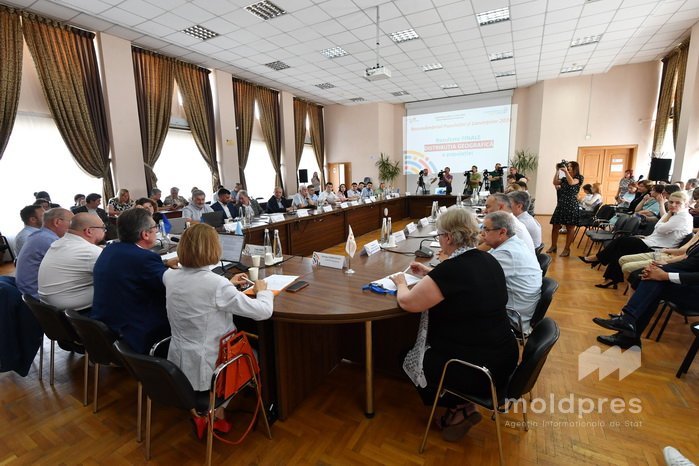
Moldova's National Statistics Bureau presents new final data of 2024 Census, provides details on population's demography, migration, education
The National Statistics Bureau (BNS) today presented a new set of final results from the 2024 Population and Housing Census, which reveal essential demographic, migratory and educational trends for Moldova. The data, made public at an event at the BNS headquarters, shows a population decrease and an ageing process, while also providing information for public policy development.
The main demographic findings show a resident population decrease of about 13 per cent compared to the 2014 census. The average age of the population has increased by 3.1 years, reaching 40.6 years, a phenomenon more pronounced in rural areas. At the same time, there is a noticed aging process, with an increase in the proportion of people over 60. The masculinity ratio is 89 men per 100 women, down from 2014.
“These final data provide a complex and updated snapshot of our society, being essential for decision-making nationally and locally. The processing and analysis of the data, including integration with administrative and spatial sources, was a complex effort. We thank all partners, including the European Union and United Nations Population Fund (UNFPA), for their constant support in carrying out this nationally important exercise,” declared Oleg Cara, Director General of the National Statistics Bureau.
As for the migration, the data show that 4.4 per cent of the resident population, over 106,000 people, were born outside the country, with most coming from former Soviet space states. There is also an observed increase in the number of residents with dual citizenship. An important aspect revealed by the census is the presence of over 15,000 forcibly displaced people, of whom 96.5 per cent are Ukrainian citizens. Internally, Chisinau and Balti municipalities stay the main attraction centers for migration from other districts of the country.
Natalia Plugaru, Deputy Representative of the UNFPA in Moldova, emphasized the quality of the data.
“The Census in Moldova observed the highest international standards and best practices, ensuring high data accuracy. The disaggregated information by gender, age and territory is vital for understanding the specific needs of different population groups and for developing effective public policies. UNFPA will continue to support the use of this data for the well-being of each citizen,” said Natalia Plugaru.
The analysis of educational characteristics shows positive trends. The literacy rate of the population aged 10 and over is 99.6 per cent. The proportion of people with higher education has increased to 19.1 per cent, compared to 14.9 per cent in 2014, being higher among women. At the time of the census, over 455,000 people, representing 20.6 per cent of the population aged 7 and over, were continuing their studies in the education system.
The Population and Housing Census (PHC) in Moldova took place starting from April 8 to July 7, 2024, being one of the largest statistical exercises conducted nationally in the last decade. The action was organized by the National Statistics Bureau, in accordance with international standards recommended by the UN and Eurostat. Over 5,500 enumerators and supervisors collected data in all settlements of the country. For the first time, the census combined classical ways (field questionnaires) with digital tools, using tablets and mobile applications for data recording. Information was collected about the population number, demographic structure, ethnicity, language, religion, education, migration, as well as about housing, facilities and living conditions.
Moldova to receive $2.113 million grant for modernizing medical rehabilitation services
Moldovan Education Ministry warns about so-called 'circular' on setting of information panels
Moldova's Superior Council of Prosecutors appoints Alexandru Machidon for Prosecutor General's office
PM says leadership must continue investing in tourism, promote Moldova as competitive destination
Nicolae Testemitanu Medical University of Moldova announces launch of contest on admission to residency
VIDEO // Protests organized by Shor group
President welcomes US and European leaders' efforts for achieving peace in Ukraine
DOC // Published in Official Journal. Moldova to have national crisis management system
Chief architect of central Moldova district prosecuted for corruption; anti-corruption officers raid more locations across country
Moldovan Labour Ministry launches help desk providing information on opening, work of family-type creches
Fourteen families from central Moldova to make their dwellings energy rehabilitation with European support
Moldova, Cyprus strengthen cooperation in context of EU Council Presidency, due to be held by Cyprus in 2026
Moldovan parliament speaker has meeting with delegation of BENELUX foreign affairs ministers
Moldova's National Statistics Bureau presents new final data of 2024 Census, provides details on population's demography, migration, education
Director-General for European Cooperation of Netherlands says Moldova on frontline of Russia's hybrid war against democracy
Cypriot Minister for European Affairs says Cyprus firmly supports EU enlargement, to promote Moldova's accession during its EU Council Presidency
Deputy Minister: We ready to open EU accession negotiations for first group of chapters
PHOTO GALLERY // BENELUX countries reaffirm support for Moldova's EU accession
Deputy PM: BENELUX - reliable partnership we can consistently rely on
About 3,200 families benefited from Appliance Voucher Program in fourth session this year
BENELUX countries support European integration of Moldova
Electronic Governance Agency tests EVO 2.0 digital wallet, compliant with European standards
National Library inaugurates exhibition on identity of Romanian language in European context
CEC: Electoral candidates can replace candidates or withdraw lists until 18 September
Benelux delegation to visit Moldova


